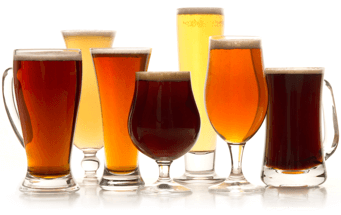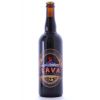Ölvisholt Brugghús - Lava
-
ABV:
9.4% -
Serving Temperature:
54–61° F -
Suggested Glassware:
Snifter, Tulip
The name Lava conjures up something sharp, explosive, and significant. This smoky imperial stout satisfies all three, but in a plush way that leaves one sated instead of exhausted. There’s a very warm, inviting core to this beer once it’s allowed to warm to proper temperature, plus a pleasant char and specialty-malt bitterness that fulfills the promise of the beer’s namesake.
Ölvisholt Brugghús’ Lava pours a pitch-black to chocolate-brown color, with just a sliver of light making it through at the edge. A medium-brown, fine-bubbled head forms and fades. A residual fencing of brown lacing stays behind, coating the sides when the liquid shifts. In the aroma one gets familiar, beechwood-smoked qualities from the beginning: an inky bitterness, mineral notes, charred meat, and bitter coffee. But the smokiness, as rich as it is, doesn’t end up overpowering the other elements. There are similarly impactful layers of milk chocolate, a café-au-lait roundness, and perhaps even a touch of herbal hop bitterness. A touch of herbal something bitterness. The sweet chocolate core is really nice, matching up to the roast notes and bitterness of the charred wood. Exceptional depth, and we haven’t even tasted this yet.
This is a far more inviting beer than the combination of “lava” plus “smoked imperial stout” tends to suggest. Even the inky bitterness in the aroma tends to overplay it. In the mouth, an expressive bitter chocolate note leads the charge, with a noticeable slickness to the palate and deeper notes to either side. There’s some rich caramel here, nuttiness, burnt sugars, and milk chocolate on the softer side of things: hints of cotton candy and a fresh, apple fruitiness. The opposite side extends as well: black licorice, char, a modestly inky smokiness, and even some dark fruits (wherever those fit in the above spectrum). The texture overall is creamy and very soft, with fine-bubbled carbonation that has an almost nitro-like feel to it. For the degrees of bitterness throughout this beer, it never becomes overly sharp on the palate, in a way that, to us, is reminiscent of something like North Coast’s Old Rasputin Russian Imperial Stout. The beers feel lightweight, basically aloft in the mouth, despite how deep and dark their notes go.
It’s worth emphasizing that the smoked angles of this beer can veer towards an acrid quality when this is poured especially cold. Allowing it to warm lets that initial sharpness open up to those lighter milk chocolate and caramel notes. This is a beer that deserves that extra time.
We expect this to age just fine for at least a year or two, with those central caramelized-sugar notes growing more pronounced from the added oxidation. There’s sufficient bitterness here that it might even last significantly longer than that. The most obvious pairing opportunity in a beer like this involves smoked pork, an excellent compliment, while this could equally add a contrasting bitter edge for something like milky coffee ice cream or a vanilla-bean custard. This should also stand up to most medium-bodied cigars (ideally with a Cameroon wrapper).
Probably the easiest way to explain why Iceland has only a handful of breweries is to further note that beer (unlike wine and spirits) wasn’t legalized in the country until 1989. Today, it’s on the upswing as it is elsewhere, with upwards of a dozen breweries for a population of just over 320,000. Lava is, arguably by a sizable margin, the most celebrated of the beers made by Iceland’s brewers. DRAFT magazine named it one of the Top 25 Beers of 2012. It took gold at the U.S. Open Beer Championships. It’s RateBeer’s top-rated Icelandic beer by far. For a brewery that spent its first 1,000 years or so as a sheep and dairy farm, that’s not too shabby.
Ölvisholt Brugghús is a small farmhouse brewery in the southwest part of the country. While their other staple beers are more subdued—a wheat ale (Freyja), red ale (Móri), and premium lager (Skjálfti)—the latter two along with Lava point to the region’s volatile nature. Skjálfti is Icelandic for “earthquake,” while Móri commemorates a lost soul from a previous eruption. We almost forgot to mention: Ölvisholt Brugghús overlooks Hekla, an active volcano.
Lava’s label, depicting a vibrant orange eruption on an icy mountaintop, represents the view from the brewhouse’s door. In their World Atlas of Beer, authors Stephen Beaumont and Tim Webb stated this about the beer itself: “The finest achievement of modern Icelandic brewing is this amazing, top-class smoke imperial stout, which hit the beer world, as it will your palate, like a volcanic eruption.” We think our members are in for a special treat this month.
Lava sees only very limited distribution in the U.S. through Vanberg & DeWulf. This beer, at least at first, was intended for the burgeoning Swedish craft beer market, but today it makes it to North America and a few other Nordic countries as well. Vanberg & DeWulf provide a few appropriate Icelandic literature choices for pairing alongside bottles of Lava, and we are nothing here at The Rare Beer Club™ if not patrons of the arts. Check out the olden Njáls saga, Noble Laureate Halldór Laxness, and Delicious Iceland by Volundur Snaer Volundarson. (On a side note: we tend to implicitly like people with names like Volundur Snaer Volundarson.)
“Smoked” beers—like “barrel-aged,” say, or “fruit” beers—cover an atypically wide territory relative to more traditional, cordoned-off beer styles. Smoked barley malt can be swapped in for traditional malt in just about any beer recipe, in the same way that (for better or worse, of course) any beer could conceivably be aged in barrels or have fruit added. “Smoked” is more a secondary descriptor, such that smoked beers can beg the question: “Sure, but what kind?”
Particularly for those of us who tuned in to Germany’s Schlenkerla offerings early on in our individual beer-tasting histories, those beers are so smoke-forward and exquisitely good that they provide a glimpse of what narrower style categories of smoked beer (or Bamberg’s style of rauchbier, at least) can look like: with a fiery but accessible focus of roast, inky smoke, and herbal wood character leading the charge. In every delicious sip of Schlenkerla’s Urbock, for example, or their Lenten-season Fastenbier, there’s no mistaking that this is a smoked beer.
Those are the first examples I tend to think about on the subject of smoked beers; we revert to the archetypes. But there are so many other opportunities to include smoked malt in beer, in ways that don’t necessarily rely upon those smoky elements to carry the whole show. Lava from Ölvisholt Brugghús is a great example of smoked beer that works on a slightly different level, putting its smoked-infused bitterness at equal volume to that underlying base imperial stout. Alaskan Brewing’s famous alder-wood-based Smoked Porter suggests a similar chord. Thinking of smoked barley malt as a measurable ingredient—whether via alder, beech wood, peat, or other combustible—clarifies its role. “Smoked” isn’t a style. It’s an extra dimension.

Unmatched Variety by style, brewery & country
Choose from Five different Beer Clubs offering unmatched variety by brewery,
country of origin, and beer style to suit your specific tastes.


